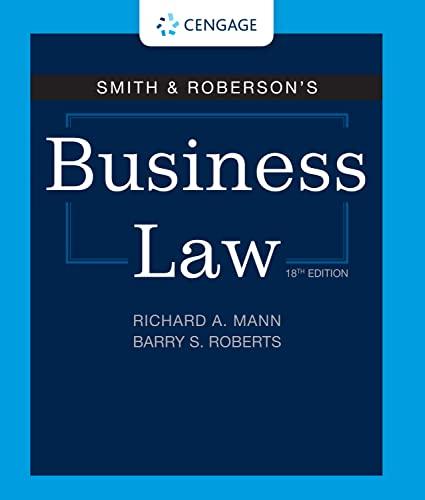Question
Please cite these cases according to blue book 1. Freedom of Speech: a. Tinker v. Des Moines Independent Community School District (1969): This case involved
Please cite these cases according to blue book 1. Freedom of Speech:
a. Tinker v. Des Moines Independent Community School District (1969): This case involved students who were suspended from school for wearing black armbands to protest the Vietnam War. The Supreme Court ruled in favor of the students, stating that they did not lose their constitutional rights to freedom of speech when they entered the school. This case established that students have the right to express their opinions, as long as it does not disrupt the educational process. b. Brandenburg v. Ohio (1969): In this case, the Supreme Court ruled that speech advocating for violence or illegal actions is protected under the First Amendment unless it is likely to incite imminent lawless action. This decision established the "imminent lawless action" test, which clarified the limits of free speech in relation to advocacy for unlawful conduct. c. Texas v. Johnson (1989): The defendant, Gregory Lee Johnson, burned an American flag during a protest at the 1984 Republican National Convention. He was convicted under a Texas law prohibiting flag desecration. However, the Supreme Court overturned the conviction, stating that flag burning is a form of symbolic speech protected by the First Amendment.
2. Freedom of Religion: a. Lemon v. Kurtzman (1971): This case involved challenges to state laws that provided financial assistance to non-public religious schools. The Supreme Court established the "Lemon test," which requires any government action concerning religion to have a secular legislative purpose, not primarily promote or inhibit religion, and not result in excessive entanglement between government and religion. b. Employment Division v. Smith (1990): In this case, two members of the Native American Church were fired from their jobs for ingesting peyote, a hallucinogenic drug, as part of their religious ceremonies. The Supreme Court ruled that the state could deny unemployment benefits to individuals dismissed for violating a state prohibition on the use of peyote, even if it was part of their religious practices. This decision limited the application of the Free Exercise Clause of the First Amendment. c. Burwell v. Hobby Lobby (2014): This case involved a challenge to the Affordable Care Act's contraceptive mandate by closely held for-profit corporations whose owners objected to certain forms of birth control on religious grounds. The Supreme Court ruled that closely held corporations could be exempt from the contraceptive mandate based on the religious beliefs of their owners, extending religious rights to corporations.
3. Equal Protection: a. Brown v. Board of Education (1954): This landmark case challenged racial segregation in public schools. State legislation creating segregated public schools for white and black children were declared illegal by the Supreme Court on the grounds that they contravened the Equal Protection Clause of the Fourteenth Amendment. The "separate but equal" theory put out in Plessy v. Ferguson was overthrown by this ruling. b. Loving v. Virginia (1967): This case involved a Virginia law that prohibited interracial marriage. The Supreme Court struck down the law, holding that it violated the Equal Protection and Due Process Clauses of the Fourteenth Amendment. This decision invalidated laws prohibiting interracial marriage in several states. c. Obergefell v. Hodges (2015): In this case, the Supreme Court held that same-sex marriage bans violate the Equal Protection Clause of the Fourteenth Amendment. The decision legalized same-sex marriage nationwide, extending marriage rights to same-sex couples on the same terms and conditions as opposite-sex couples.
Step by Step Solution
There are 3 Steps involved in it
Step: 1

Get Instant Access to Expert-Tailored Solutions
See step-by-step solutions with expert insights and AI powered tools for academic success
Step: 2

Step: 3

Ace Your Homework with AI
Get the answers you need in no time with our AI-driven, step-by-step assistance
Get Started


